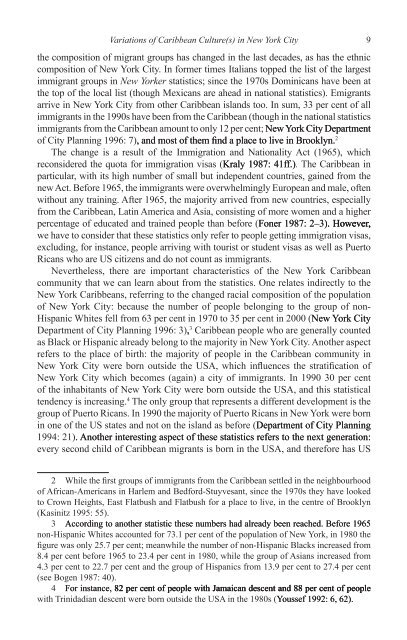You also want an ePaper? Increase the reach of your titles
YUMPU automatically turns print PDFs into web optimized ePapers that Google loves.
Variations <strong>of</strong> <strong>Caribbean</strong> Culture(s) <strong>in</strong> <strong>New</strong> <strong>York</strong> <strong>City</strong> 9<br />
<strong>the</strong> composition <strong>of</strong> migrant groups has changed <strong>in</strong> <strong>the</strong> last decades, as has <strong>the</strong> ethnic<br />
composition <strong>of</strong> <strong>New</strong> <strong>York</strong> <strong>City</strong>. In former times Italians topped <strong>the</strong> list <strong>of</strong> <strong>the</strong> largest<br />
immigrant groups <strong>in</strong> <strong>New</strong> <strong>York</strong>er statistics; s<strong>in</strong>ce <strong>the</strong> 1970s Dom<strong>in</strong>icans have been at<br />
<strong>the</strong> top <strong>of</strong> <strong>the</strong> local list (though Mexicans are ahead <strong>in</strong> national statistics). Emigrants<br />
arrive <strong>in</strong> <strong>New</strong> <strong>York</strong> <strong>City</strong> from o<strong>the</strong>r <strong>Caribbean</strong> islands too. In sum, 33 per cent <strong>of</strong> all<br />
immigrants <strong>in</strong> <strong>the</strong> 1990s have been from <strong>the</strong> <strong>Caribbean</strong> (though <strong>in</strong> <strong>the</strong> national statistics<br />
immigrants from <strong>the</strong> <strong>Caribbean</strong> amount to only 12 per cent; <strong>New</strong> <strong>York</strong> <strong>City</strong> Department<br />
<strong>of</strong> <strong>City</strong> Plann<strong>in</strong>g 1996: 7), and most <strong>of</strong> <strong>the</strong>m f<strong>in</strong>d a place to live <strong>in</strong> Brooklyn. 2<br />
The change is a result <strong>of</strong> <strong>the</strong> Immigration and Nationality Act (1965), which<br />
reconsidered <strong>the</strong> quota for immigration visas (Kraly 1987: 41ff.). The <strong>Caribbean</strong> <strong>in</strong><br />
particular, with its high number <strong>of</strong> small but <strong>in</strong>dependent countries, ga<strong>in</strong>ed from <strong>the</strong><br />
new Act. Before 1965, <strong>the</strong> immigrants were overwhelm<strong>in</strong>gly European and male, <strong>of</strong>ten<br />
without any tra<strong>in</strong><strong>in</strong>g. After 1965, <strong>the</strong> majority arrived from new countries, especially<br />
from <strong>the</strong> <strong>Caribbean</strong>, Lat<strong>in</strong> America and Asia, consist<strong>in</strong>g <strong>of</strong> more women and a higher<br />
percentage <strong>of</strong> educated and tra<strong>in</strong>ed people than before (Foner 1987: 2–3). However,<br />
we have to consider that <strong>the</strong>se statistics only refer to people gett<strong>in</strong>g immigration visas,<br />
exclud<strong>in</strong>g, for <strong>in</strong>stance, people arriv<strong>in</strong>g with tourist or student visas as well as Puerto<br />
Ricans who are US citizens and do not count as immigrants.<br />
Never<strong>the</strong>less, <strong>the</strong>re are important characteristics <strong>of</strong> <strong>the</strong> <strong>New</strong> <strong>York</strong> <strong>Caribbean</strong><br />
community that we can learn about from <strong>the</strong> statistics. One relates <strong>in</strong>directly to <strong>the</strong><br />
<strong>New</strong> <strong>York</strong> <strong>Caribbean</strong>s, referr<strong>in</strong>g to <strong>the</strong> changed racial composition <strong>of</strong> <strong>the</strong> population<br />
<strong>of</strong> <strong>New</strong> <strong>York</strong> <strong>City</strong>: because <strong>the</strong> number <strong>of</strong> people belong<strong>in</strong>g to <strong>the</strong> group <strong>of</strong> non-<br />
Hispanic Whites fell from 63 per cent <strong>in</strong> 1970 to 35 per cent <strong>in</strong> 2000 (<strong>New</strong> <strong>York</strong> <strong>City</strong><br />
Department <strong>of</strong> <strong>City</strong> Plann<strong>in</strong>g 1996: 3), 3 <strong>Caribbean</strong> people who are generally counted<br />
as Black or Hispanic already belong to <strong>the</strong> majority <strong>in</strong> <strong>New</strong> <strong>York</strong> <strong>City</strong>. Ano<strong>the</strong>r aspect<br />
refers to <strong>the</strong> place <strong>of</strong> birth: <strong>the</strong> majority <strong>of</strong> people <strong>in</strong> <strong>the</strong> <strong>Caribbean</strong> community <strong>in</strong><br />
<strong>New</strong> <strong>York</strong> <strong>City</strong> were born outside <strong>the</strong> <strong>USA</strong>, which <strong>in</strong>fluences <strong>the</strong> stratification <strong>of</strong><br />
<strong>New</strong> <strong>York</strong> <strong>City</strong> which becomes (aga<strong>in</strong>) a city <strong>of</strong> immigrants. In 1990 30 per cent<br />
<strong>of</strong> <strong>the</strong> <strong>in</strong>habitants <strong>of</strong> <strong>New</strong> <strong>York</strong> <strong>City</strong> were born outside <strong>the</strong> <strong>USA</strong>, and this statistical<br />
tendency is <strong>in</strong>creas<strong>in</strong>g. 4 The only group that represents a different development is <strong>the</strong><br />
group <strong>of</strong> Puerto Ricans. In 1990 <strong>the</strong> majority <strong>of</strong> Puerto Ricans <strong>in</strong> <strong>New</strong> <strong>York</strong> were born<br />
<strong>in</strong> one <strong>of</strong> <strong>the</strong> US states and not on <strong>the</strong> island as before (Department <strong>of</strong> <strong>City</strong> Plann<strong>in</strong>g<br />
1994: 21). Ano<strong>the</strong>r <strong>in</strong>terest<strong>in</strong>g aspect <strong>of</strong> <strong>the</strong>se statistics refers to <strong>the</strong> next generation:<br />
every second child <strong>of</strong> <strong>Caribbean</strong> migrants is born <strong>in</strong> <strong>the</strong> <strong>USA</strong>, and <strong>the</strong>refore has US<br />
2 While <strong>the</strong> first groups <strong>of</strong> immigrants from <strong>the</strong> <strong>Caribbean</strong> settled <strong>in</strong> <strong>the</strong> neighbourhood<br />
<strong>of</strong> African-Americans <strong>in</strong> Harlem and Bedford-Stuyvesant, s<strong>in</strong>ce <strong>the</strong> 1970s <strong>the</strong>y have looked<br />
to Crown Heights, East Flatbush and Flatbush for a place to live, <strong>in</strong> <strong>the</strong> centre <strong>of</strong> Brooklyn<br />
(Kas<strong>in</strong>itz 1995: 55).<br />
3 Accord<strong>in</strong>g to ano<strong>the</strong>r statistic <strong>the</strong>se numbers had already been reached. Before 1965<br />
non-Hispanic Whites accounted for 73.1 per cent <strong>of</strong> <strong>the</strong> population <strong>of</strong> <strong>New</strong> <strong>York</strong>, <strong>in</strong> 1980 <strong>the</strong><br />
figure was only 25.7 per cent; meanwhile <strong>the</strong> number <strong>of</strong> non-Hispanic Blacks <strong>in</strong>creased from<br />
8.4 per cent before 1965 to 23.4 per cent <strong>in</strong> 1980, while <strong>the</strong> group <strong>of</strong> Asians <strong>in</strong>creased from<br />
4.3 per cent to 22.7 per cent and <strong>the</strong> group <strong>of</strong> Hispanics from 13.9 per cent to 27.4 per cent<br />
(see Bogen 1987: 40).<br />
4 For <strong>in</strong>stance, 82 per cent <strong>of</strong> people with Jamaican descent and 88 per cent <strong>of</strong> people<br />
with Tr<strong>in</strong>idadian descent were born outside <strong>the</strong> <strong>USA</strong> <strong>in</strong> <strong>the</strong> 1980s (Youssef 1992: 6, 62).


















